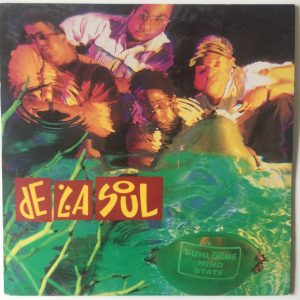When De La Soul emerged from the effervescent haze of the late 1980s hip-hop scene with their maiden album, they were immediately heralded as architects of a new dawn in rap. By the time Buhloone Mindstate was conceived, the landscape had shifted. The early ’90s witnessed a burgeoning renaissance in hip-hop, with a surge of acts bringing a kaleidoscope of sounds and lyrical depth to the genre. Amidst this creative ferment, De La Soul—comprising Posdnuos, Trugoy, and Maseo. They weren’t just participants but pioneers. The group already etched their names into the annals of music with their first two albums. Buhloone Mindstate, released in 1993, was a continuation of their artistry. Yet, it signaled a departure. It was a conscious decision to inflate their music ‘like a balloon’ that could rise but never burst. The metaphor for growth without selling out.
The album arrived at a pivotal moment for the group. They sought to further challenge the parameters of hip-hop without severing the umbilical cord to its core. The industry buzzed with the rise of gangsta rap. Yet De La Soul remained untempted by the gritty allure of the streets that now dominated the charts. Instead, they doubled down on their esoteric approach. They wove a tapestry of sounds that flirted with jazz, funk, and soul while still anchoring their work in the grounded, sample-heavy ethos of the era. With Buhloone Mindstate, they chose to collaborate with icons like the jazz saxophonist Maceo Parker. It was a move that bridged genres and generations. This Infused the album with a sense of timeless integrity that challenged the fleeting trends of the day.
Soundscapes & Artistry
With Buhloone Mindstate, De La Soul dove into an exploratory musical venture that defied the conventions of early ’90s hip-hop. The beats are not just backdrops but are integral narratives within themselves. Each track tells a story through its unique fusion of samples and live instrumentation. This sonic diversity is evident in tracks like “I Be Blowin’.” It showcased Maceo Parker’s soul-stirring saxophone melodies, devoid of lyrics yet speaking volumes in the language of jazz-infused hip-hop. It’s in such bold creative decisions that Buhloone Mindstate stands as a testament to De La Soul’s artistry. It’s a clear departure from the era’s escalating obsession with hard-hitting beats and hardcore rap narratives.
Yet, the album was more than an avant-garde experiment. It was a statement of purpose from a group that refused to be pigeonholed by their early success. Lyrically, Buhloone Mindstate is rich with introspective musings, societal critiques, and playful yet poignant commentaries on the state of hip-hop. It’s this blend of the experimental and the elemental that solidified the album’s place in the pantheon of hip-hop: innovative yet introspective, forward-thinking yet foundational.
Commercial Success & Industry Acclaim
The commercial reception of Buhloone Mindstate bore the paradox of De La Soul’s career at the juncture. It was an album that achieved respectable sales. Yet its numbers were modest compared to the seismic waves of their debut. It charted at No. 40 on the Billboard 200 and No. 10 on the R&B/Hip-Hop album chart. The album’s performance reflected not a diminished quality but a fiercely competitive era in hip-hop. Nonetheless, the record swiftly became a darling among critics and a cult classic for fans, who revered it for its uncompromising creativity and resistance to mainstream trends. The single “Breakadawn,” with its Michael Jackson sample, became a standout hit, showcasing De La Soul’s ability to craft a commercially viable track without sacrificing their artistic integrity.
While not always reflected in towering sales figures, the industry’s acclaim was evident in the respect garnered from peers and the influence echoed in subsequent works by other artists. The album received critical accolades for its innovative use of live instruments and its fearless, genre-blending approach. In the years following its release, Buhloone Mindstate has been retrospectively cited as an essential building block in the evolution of alternative hip-hop, with many modern artists tipping their hats to De La Soul’s pioneering work on this project. The album’s artistry and warm reception solidified the trio’s reputation as vanguards of the genre, unafraid to push boundaries and challenge the status quo.
Cultural Echo & Timeless Appeal
The echoes of Buhloone Mindstate reverberate beyond the confines of its initial release, capturing the essence of an era while simultaneously transcending it. The album’s influence is palpable in the tapestry of today’s hip-hop landscape, where its experimental spirit lives on in artists who refuse to be bound by genre. The cultural impact of De La Soul‘s third opus is measured not just in sales or accolades but in the intangible ways it has shaped the dialogue around what hip-hop can be—intellectually rich, musically diverse, and boundlessly creative. As hip-hop continues to evolve as a global force, Buhloone Mindstate stands as a beacon of artistic freedom, a reminder that commercial success and critical acclaim are not mutually exclusive with cultural contribution.
Now, decades since its release, Buhloone Mindstate maintains a profound relevance, its themes of individuality and authenticity resonating with new generations. In an industry often criticized for commodifying creativity, De La Soul’s work is a bulwark against such trends, a testament to the group’s vision of hip-hop as an art form, not just a commercial enterprise. The album’s anniversary is a moment to reflect on its legacy—a legacy that has not bloated with time but rather has matured, expanding the boundaries of musical innovation and integrity in ways that continue to inspire and influence.
The post De La Soul’s “Buhloone Mindstate” Turns 30 appeared first on HotNewHipHop.

